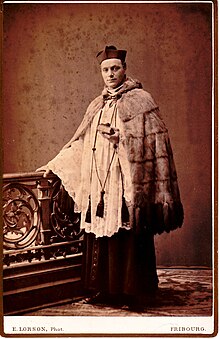Almuce
The almuce or amess is defined by E. L. Cutts as a tippet of black cloth with a hood attached, lined with fur, worn in choir by canons, and in some counties of England by parochial rectors.
[5] The introduction of the biretta in the 15th century tended to replace the use of the almuce as a head-covering, and the hood now became smaller, while the cape was enlarged till in some cases it fell below the elbows.
Another form of almuce at this period covered the back, but was cut away at the shoulders so as to leave the arms free, while in front it was elongated into two stole-like ends.
[5] Almuces were occasionally made of silk or wool, but from the 13th century onward usually of fur, the hem being sometimes fringed with tails.
By the 16th century the almuce had become definitely established as the distinctive choir vestment of canons; but it had ceased to have any practical use, and was often only carried over the left arm as a symbol of office.
